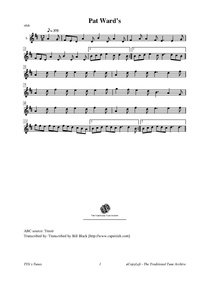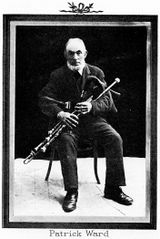Template:Pagina principale/Vetrina: Difference between revisions
No edit summary |
No edit summary |
||
| Line 1: | Line 1: | ||
{{SheetMusic | {{SheetMusic | ||
|f_track= | |f_track=Ask My Father Pat Wards Jig.mp3 | ||
|f_pdf= | |f_pdf=Pat Ward's Jig.pdf | ||
|f_artwork= | |f_artwork=Ward.jpg | ||
|f_tune_name= | |f_tune_name=Pat Ward's Jig | ||
|f_track_title= | |f_track_title=Pat Ward's Jig | ||
|f_section=abc | |f_section=abc | ||
|f_played_by=[https://soundcloud.com/ | |f_played_by=[https://soundcloud.com/oisinmcauley Oisín McAuley] | ||
|f_notes= | |f_notes= Pat Ward (1847-1928) | ||
|f_caption= | |f_caption=His first lesson in writhing music...was not unattended with difficulties. Having neither pen nor ink, he was told by his teacher, "a dark man," to burn a furze stick and write with its calcined end. This expedient served fairly well. From that day to his he says that whenever he takes a pen in his hand to write music his mind reverts to "The Flogging Reel", which was the first tune set down in the manner mentioned. | ||
|f_source=[https://soundcloud.com/ | |f_source=[https://soundcloud.com/oisinmcauley/ask-my-father-pat-wards-jig Soundcloud] | ||
|f_pix=420 | |f_pix=420 | ||
|f_picpix=200 | |f_picpix=200 | ||
|f_article=[[ | |f_article=[[Pat Ward's Jig| '''Pat Ward's Jig''']] | ||
There is a brief biographical sketch and a photograph of Ward in Francis O'Neill's '''Irish Minstrels and Musicians''' (1913, pp. 317-319), giving his date of birth as 1847 in the Parish of Drumconrath, County Meath, remarking that he "had attained considerable command of the fiddle before commencing the practice of the Union pipes." | |||
<blockquote> | |||
''His first lesson in writhing music...was not unattended with difficulties. Having neither pen nor ink, he was told by'' | |||
''his teacher, "a dark man," to burn a furze stick and write with its calcined end. This expedient served fairly well.'' | |||
''From that day to his he says that whenever he takes a pen in his hand to write music his mind reverts to'' | |||
"[[Flogging Reel (The)]]", ''which was the first tune set down in the manner mentioned.'' <br> | |||
''In his repertory are many tunes seemingly peculiar to the County Louth. He had played at several Feis Ceoil and Oirachtas'' | |||
''for the last ten years and has been awarded several prizes. At the Oireachtas in 1907 he won second prize, the first'' | |||
''going to George McCarthy, and in 1911 he again captured second honors. Taking into consideration that Ward is not a'' | |||
''professional piper, but a plowman since early manhood, his execution on the double changer is indeed remarkable.'' [p. 319]. | |||
</blockquote> | |||
Seamus Ennis, in liner notes to his album "The Pure Drop," remarks: | |||
<blockquote> | <blockquote> | ||
'' | ''As a child, I remember Pat Ward. He was a native of Drogheda, an old man with a crescent shaped beard. He played a double'' ''changer--two reeds, two bores and two stop holes for each finger, as compared to the usual single piece. I would compare his'' ''tone with that of a very mellow concertina, to the best of my recollection, for I was but a child when he was tragically killed'' ''by a motor-bus near his house. My father learned this tune from him and as he had no name for it we referred to it as above at'' ''all times. Notice that the accepted performing rhythm of the single jig is nearly identical with that of a hornpipe--a'' | ||
'' 'common' tune simulated by the four threes of 12/8.'' | |||
'' | |||
'' | |||
'' | |||
'' | |||
</blockquote> | </blockquote> | ||
}} | }} | ||
Revision as of 09:57, 26 February 2023

Played by: Oisín McAuley
Source: Soundcloud
Image: Pat Ward (1847-1928)

There is a brief biographical sketch and a photograph of Ward in Francis O'Neill's Irish Minstrels and Musicians (1913, pp. 317-319), giving his date of birth as 1847 in the Parish of Drumconrath, County Meath, remarking that he "had attained considerable command of the fiddle before commencing the practice of the Union pipes."
His first lesson in writhing music...was not unattended with difficulties. Having neither pen nor ink, he was told by his teacher, "a dark man," to burn a furze stick and write with its calcined end. This expedient served fairly well. From that day to his he says that whenever he takes a pen in his hand to write music his mind reverts to "Flogging Reel (The)", which was the first tune set down in the manner mentioned.
In his repertory are many tunes seemingly peculiar to the County Louth. He had played at several Feis Ceoil and Oirachtas for the last ten years and has been awarded several prizes. At the Oireachtas in 1907 he won second prize, the first going to George McCarthy, and in 1911 he again captured second honors. Taking into consideration that Ward is not a professional piper, but a plowman since early manhood, his execution on the double changer is indeed remarkable. [p. 319].
Seamus Ennis, in liner notes to his album "The Pure Drop," remarks:
As a child, I remember Pat Ward. He was a native of Drogheda, an old man with a crescent shaped beard. He played a double changer--two reeds, two bores and two stop holes for each finger, as compared to the usual single piece. I would compare his tone with that of a very mellow concertina, to the best of my recollection, for I was but a child when he was tragically killed by a motor-bus near his house. My father learned this tune from him and as he had no name for it we referred to it as above at all times. Notice that the accepted performing rhythm of the single jig is nearly identical with that of a hornpipe--a 'common' tune simulated by the four threes of 12/8.
...more at: Pat Ward's Jig - full Score(s) and Annotations
X: 1 T: Pat Ward's S: Treoir M: 12/8 L: 1/8 Q: 375 R: slide Z: Transcribed by Bill Black [1] K: D A2 G | FED A2 D B2 D A2 D | F2 A A2 F E3 E2 G | FED A2 D B2 D A2 D |1 Bcd e2 c d2 B :|2 Bcd e2 c d3 dcB || A2 d f2 d e2 d f2 d | A2 d f2 d e3 d2 f | A2 d f2 d e2 d e2 f | g2 f e2 d B3 A2 F | A2 d f2 d e2 d f2 d | A2 d f2 d e3 e2 f | gfe fed fed cBA |1 Bcd edc d3 d2 B :|2 Bcd edc d3 d3 ||
